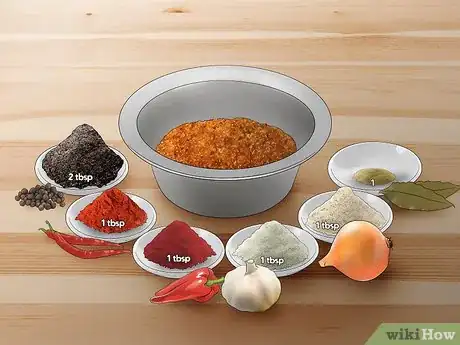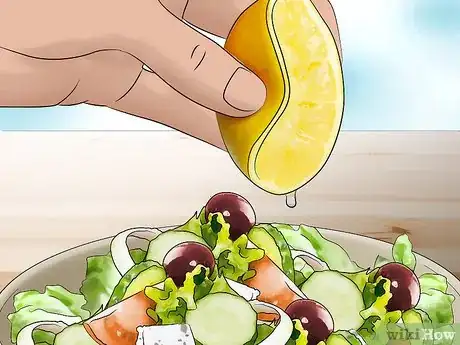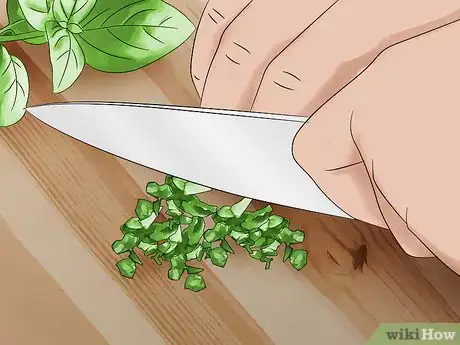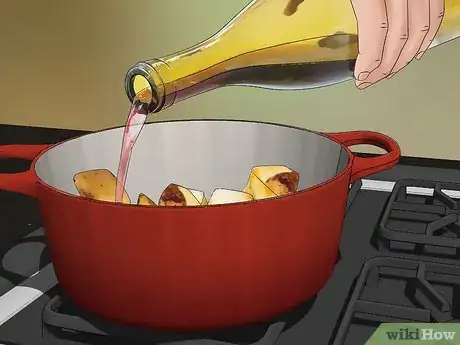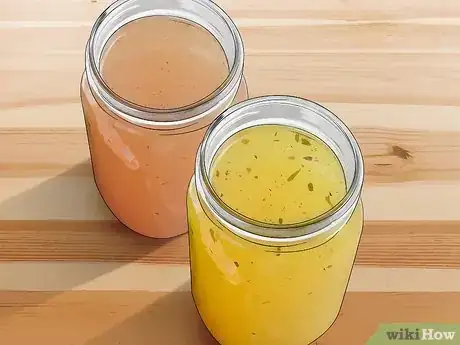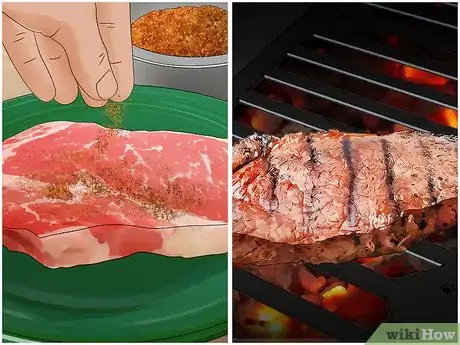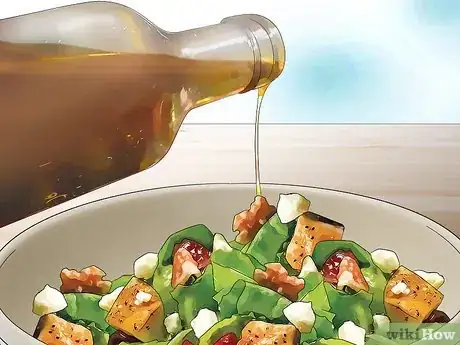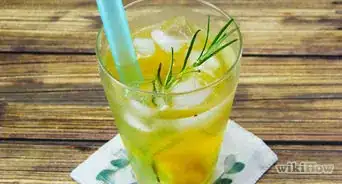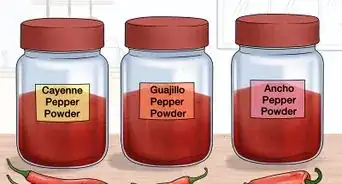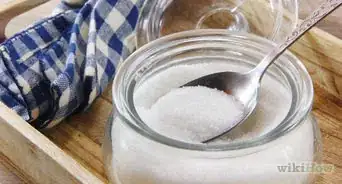This article was co-authored by Jennifer Lease, RD, CDN and by wikiHow staff writer, Jessica Gibson. Jennifer Lease is a Registered Dietitian and Trained Chef based in Denver, Colorado. With six years of experience in the food and nutrition fields, she specializes in a plant-forward approach to applying nutrition information to cooking. Jennifer holds a BS in Dietetics and a Dietetic Internship Certificate from The University of Delaware. She also received her professional chef training from The Natural Gourmet Institute for Health and Culinary Arts.
There are 9 references cited in this article, which can be found at the bottom of the page.
This article has been viewed 72,529 times.
Salt is one of the most commonly used seasonings for adding instant flavor to food. If you find yourself frequently reaching for the salt shaker while cooking your food or at the table, it may be time to cut back, especially if you're trying to lower your sodium intake. Fortunately, you don't need to sacrifice flavor when cutting out the salt. Create ready-to-use salt-free seasonings for poultry, beef, and fish, as well as an all-purpose seasoning to replace salt. You could also use ingredients like lemon, vinegar, wine, and stock to add flavor to your food without turning to the salt.
Steps
Creating Salt-Free Seasonings
-
1Mix a no-salt poultry seasoning. Add a rich flavor to your turkey or chicken by using a no-salt poultry seasoning. Drizzle the meat with some olive oil and one or two teaspoons of your seasoning. Cook the meat according to your recipe. To make the no-salt poultry seasoning, measure out and combine:[1]
-
2Create a no-salt seasoning for beef. If you're used to simply seasoning your steaks or roasts with salt and pepper, it's probably time to change up the flavors. Swap out salt and pepper for a no-salt beef seasoning that enhances the flavors of most cuts of beef. Sprinkle about 1/4 of a teaspoon of the seasoning for each pound of meat you're preparing. For the seasoning, you'll need to mix:[6]Advertisement
-
3Make a salt-free seasoning for fish. If you'd like to give any type of fish or shrimp a zesty flavor with a little heat, create a salt-free version of seafood creole seasoning. Sprinkle the seafood with a little of the mixture and saute or blacken the seafood for additional flavor. You'll need to mix together:[11]
-
4Create an all-purpose seasoning without salt. If you're someone who regularly reaches for the salt on the table, mix up an all-purpose seasoning that can replace your table salt. This way, you can reach for an instant flavor fix for your meals. Mix up this all purpose seasoning and store it in a spice jar. You'll need to combine:[15]
- 2 tablespoons of black pepper
- 1 tablespoon of cayenne pepper
- 1 tablespoon of paprika
- 1 tablespoon of onion powder
- 1 tablespoon of garlic powder
- 1 ground bay leaf
Seasoning With Flavorful Ingredients
-
1Use a squirt of lemon. Lemons are great for replacing salt since they give the same zip and depth of flavor to food. You can grate the zest and include it in baked foods or squeeze the lemon and add a squirt to your food.[16] Lemon works well in:
- Salad dressings
- Pastas
- Poultry or seafood dishes
- Breadcrumbs
-
2Cook with fresh herbs. Try to keep several types of fresh herbs on hand so you're more likely to cook with them.[17] For even easier use, consider mincing (chopping them finely) and storing them in the fridge so you can quickly season or garnish your food. Try these fresh herbs that pair well with a variety of foods:[18]
- Basil
- Dill:
- Parsley
- Rosemary
- Thyme
- Chives
-
3Season the food with a little wine. Cooking with red or white wine is a great way to concentrate flavor in your food. Add about 1/2 cup of red or white wine to your dish and let it cook down so the wine reduces. Avoid using cooking wine or sherry which usually have salt added and are high in sodium.[19]
- For example, add red wine to a pasta sauce and let it simmer for an hour to amplify the flavor. Or you can add a splash of white wine to a seafood pasta sauce and let it cook down.
-
4Use chicken, vegetable or beef stock. If you're cooking something that calls for a lot of water, you can usually replace it with a chicken, vegetable or beef stock. Ensure that the stock is salt-free (which is easy to do if you're making it at home). The stock will be more flavorful than the water and you won't even need to add salt.
- For example, if you're making a vegetable soup, replace the water with a stock for additional flavor.
-
5Grill your food. Mix up a quick salt-free marinade for meat or vegetables and heat up your grill. Grilling your food will give it a great smoky flavor and you won't even need to use salt. Try adding hickory or mesquite chips to the grill or grilling your food on a cedar wood plank for extra flavor.[20]
- Try using a citrus-based marinade for even more seasoning. For example, marinate chicken in a lime vinaigrette and grill it for a bit of a smoky taste.
-
6Add a little vinegar. There are a variety of vinegars you can use to replace salt. Try a splash of red wine vinegar, white wine vinegar, balsamic vinegar, or apple cider vinegar to give additional flavor to your food. Studies have shown that vinegar can enhance the salty flavor of foods. You can use vinegar in:[21]
- Stews
- Salads
- Marinades
- Braised vegetables
Expert Q&A
-
QuestionHow can I flavor food without salt?
 Jennifer Lease, RD, CDNJennifer Lease is a Registered Dietitian and Trained Chef based in Denver, Colorado. With six years of experience in the food and nutrition fields, she specializes in a plant-forward approach to applying nutrition information to cooking. Jennifer holds a BS in Dietetics and a Dietetic Internship Certificate from The University of Delaware. She also received her professional chef training from The Natural Gourmet Institute for Health and Culinary Arts.
Jennifer Lease, RD, CDNJennifer Lease is a Registered Dietitian and Trained Chef based in Denver, Colorado. With six years of experience in the food and nutrition fields, she specializes in a plant-forward approach to applying nutrition information to cooking. Jennifer holds a BS in Dietetics and a Dietetic Internship Certificate from The University of Delaware. She also received her professional chef training from The Natural Gourmet Institute for Health and Culinary Arts.
Registered Dietitian & Trained Chef You can use any seasoning you like! Spices and dried herbs are great ways to add tons of flavor to a dish without needing to use as much salt.
You can use any seasoning you like! Spices and dried herbs are great ways to add tons of flavor to a dish without needing to use as much salt. -
QuestionWhat spices can replace salt?
 Jennifer Lease, RD, CDNJennifer Lease is a Registered Dietitian and Trained Chef based in Denver, Colorado. With six years of experience in the food and nutrition fields, she specializes in a plant-forward approach to applying nutrition information to cooking. Jennifer holds a BS in Dietetics and a Dietetic Internship Certificate from The University of Delaware. She also received her professional chef training from The Natural Gourmet Institute for Health and Culinary Arts.
Jennifer Lease, RD, CDNJennifer Lease is a Registered Dietitian and Trained Chef based in Denver, Colorado. With six years of experience in the food and nutrition fields, she specializes in a plant-forward approach to applying nutrition information to cooking. Jennifer holds a BS in Dietetics and a Dietetic Internship Certificate from The University of Delaware. She also received her professional chef training from The Natural Gourmet Institute for Health and Culinary Arts.
Registered Dietitian & Trained Chef Try using fresh herbs, fresh citrus zest and juice. You can also use cooking methods that add tons of flavor, like roasting or sauteing with olive oil and garlic.
Try using fresh herbs, fresh citrus zest and juice. You can also use cooking methods that add tons of flavor, like roasting or sauteing with olive oil and garlic. -
QuestionAre there others ways to contribute onion to flavor?
 HumanBeingTop AnswererChives have a flavor similar to onions. Shallots and scallions are types of onions you could use instead of classic brown or red onions. Onion powder is an alternative, too.
HumanBeingTop AnswererChives have a flavor similar to onions. Shallots and scallions are types of onions you could use instead of classic brown or red onions. Onion powder is an alternative, too.
References
- ↑ https://www.thekitchn.com/from-the-spice-cupboard-poultr-131895
- ↑ Jennifer Lease, RD, CDN. Registered Dietitian & Trained Chef. Expert Interview. 15 September 2021.
- ↑ Jennifer Lease, RD, CDN. Registered Dietitian & Trained Chef. Expert Interview. 15 September 2021.
- ↑ Jennifer Lease, RD, CDN. Registered Dietitian & Trained Chef. Expert Interview. 15 September 2021.
- ↑ Jennifer Lease, RD, CDN. Registered Dietitian & Trained Chef. Expert Interview. 15 September 2021.
- ↑ http://allrecipes.com/recipe/232761/all-purpose-no-salt-seasoning-mix/
- ↑ Jennifer Lease, RD, CDN. Registered Dietitian & Trained Chef. Expert Interview. 15 September 2021.
- ↑ Jennifer Lease, RD, CDN. Registered Dietitian & Trained Chef. Expert Interview. 15 September 2021.
- ↑ Jennifer Lease, RD, CDN. Registered Dietitian & Trained Chef. Expert Interview. 15 September 2021.
- ↑ Jennifer Lease, RD, CDN. Registered Dietitian & Trained Chef. Expert Interview. 15 September 2021.
- ↑ http://www.epicurious.com/recipes/food/views/creole-seafood-seasoning-104680
- ↑ Jennifer Lease, RD, CDN. Registered Dietitian & Trained Chef. Expert Interview. 15 September 2021.
- ↑ Jennifer Lease, RD, CDN. Registered Dietitian & Trained Chef. Expert Interview. 15 September 2021.
- ↑ Jennifer Lease, RD, CDN. Registered Dietitian & Trained Chef. Expert Interview. 15 September 2021.
- ↑ http://www.nhlbi.nih.gov/health/educational/healthdisp/pdf/tipsheets/Tips-to-Eat-Less-Salt-and-Sodium.pdf
- ↑ Jennifer Lease, RD, CDN. Registered Dietitian & Trained Chef. Expert Interview. 15 September 2021.
- ↑ Jennifer Lease, RD, CDN. Registered Dietitian & Trained Chef. Expert Interview. 15 September 2021.
- ↑ https://www.healthydiningfinder.com/blogs-recipes-more/Ask-the-Dietitians/5-Herbs-to-replace-the-salt
- ↑ http://www.bhg.com/recipes/healthy/low-sodium/how-to-cook-with-less-salt/#page=5
- ↑ http://www.bhg.com/recipes/healthy/low-sodium/how-to-cook-with-less-salt/#page=6
- ↑ http://www.foodnavigator.com/Science/Vinegar-could-be-used-for-salt-reduction-Study
About This Article
It might seem hard to season your food without salt, but there are many herbs and seasonings you can use to make your food flavorful! For instance, you can squeeze a lemon wedge over salads, pastas, or poultry to give them a bright flavor. You can also add fresh herbs like basil, dill, rosemary, thyme, and chives to your food to season it. In addition, try adding white wine, chicken or vegetable stock, or vinegar to your dishes to give them a richer taste. For tips on how to make your own seasoning blends for chicken, beef, or vegetables, read on!




